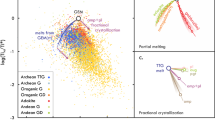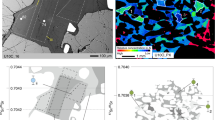Abstract
GREAT problems exist in the determination of an ancient geothermal gradient. An attempt has been made by Boyd1, based primarily upon the equilibration conditions of coexisting pyroxenes in garnet lherzolite xenoliths from the Thaba Putsoa, Letseng and Mothae kimberlite intrusions in northern Lesotho. He derived the equilibration temperature of the xenoliths from the amount of enstatite in solid solution in the diopside2, and estimated the pressure from the amount of Al2O3 in the orthopyroxene3. He argued that, for a group of lherzolite xenoliths, a line joining a series of pyroxene-derived pressure/temperature points should define the geothermal gradient in the mantle below northern Lesotho during the Cretaceous when the xenoliths were entrained by the kimberlite during its ascent. He found a Cretaceous gradient similar to that in present-day shield areas between depths of 100 and 150 km, though from 150 to 200 km depth it was considerably steeper. Moreover, whereas the lherzolites outlining the shallower ‘normal’ part of the gradient are of granular texture, those outlining the high-temperature, steeper and deeper segment exhibit a range of deformation and recrystallisation textures (the porphyroclastic and mosaic textures in the classification scheme of Bouiller and Nicolas4).
This is a preview of subscription content, access via your institution
Access options
Subscribe to this journal
Receive 51 print issues and online access
$199.00 per year
only $3.90 per issue
Buy this article
- Purchase on Springer Link
- Instant access to full article PDF
Prices may be subject to local taxes which are calculated during checkout
Similar content being viewed by others
References
Boyd, F. R., Geochim. cosmochim. Acta, 37, 2533–2547 (1973).
Davis, B. T. C., and Boyd, F. R., J. geophys. Res., 71, 3567–3576 (1966).
Macgregor, I. D., 59, 110–119 (1974).
Bouiller, A. M., and Nicolas, A., in Lesotho Kimberlites, 57–76 (Lesotho National Development Corporation, Maseru, 1973).
Nixon, P. H., and Boyd, F. R., ibid., 48–56.
Johnston, J. L., Extended Abst. int. Conf. Kimberlites, Cape Town, 181–183 (1973).
Macgregor, I. D., Phys. Chem. Earth, 9, 455–466 (1975).
Hearn, B. C., Jr, and Boyd, F. R., Phys. Chem. Earth, 9, 247–256 (1975).
Eggler, D. H., and MacCallum, M. E., Yb. Carnegie Instn Wash., 73, 294–300 (1974).
Borley, G. D., Nature, 254, 489–491 (1975).
Cox, K. G., Gurney, J. J., and Harte, B., in Lesotho Kimberlites, 76–100 (Lesotho National Development Corporation, Maseru, 1973).
Harte, B., Cox, K. G., and Gurney, J. J., Phys. Chem. Earth, 9, 477–506 (1975).
Gurney, J. J., Harte, B., and Cox, K. G., Phys. Chem. Earth, 9, 506–524 (1975).
Boyd, F. R., Yb. Carnegie Instn Wash., 73, 285–294 (1974).
Bouiller, A. H., and Nicolas, A., Phys. Chem. Earth, 9, 467–476 (1975).
Green, H. W., II, and Gueguen, Y., Nature, 249, 617–620 (1974).
Du Toil, A. L., The Geology of South Africa (Oliver and Boyd, Edinburgh, 1954).
Author information
Authors and Affiliations
Rights and permissions
About this article
Cite this article
DAWSON, J., GURNEY, J. & LAWLESS, P. Palaeogeothermal gradients derived from xenoliths in kimberlite. Nature 257, 299–300 (1975). https://doi.org/10.1038/257299a0
Received:
Accepted:
Published:
Issue Date:
DOI: https://doi.org/10.1038/257299a0
This article is cited by
-
Garnet lherzolite xenoliths in the kimberlites of northern Lesotho: revised P-T equilibration conditions and upper mantle Palaeogeotherm
Contributions to Mineralogy and Petrology (1987)
-
Garnet lherzolites from the Hanaus-I and Louwrensia kimberlites of Namibia
Contributions to Mineralogy and Petrology (1984)
-
Can Kimberlites be generated from an ordinary mantle?
Nature (1981)
-
Geothermometry of garnet lherzolite nodules with special reference to those from the kimberlites of Northern Lesotho
Contributions to Mineralogy and Petrology (1980)
-
Garnet lherzolites from Somerset Island, Canada and aspects of the nature of perturbed geotherms
Contributions to Mineralogy and Petrology (1978)
Comments
By submitting a comment you agree to abide by our Terms and Community Guidelines. If you find something abusive or that does not comply with our terms or guidelines please flag it as inappropriate.



